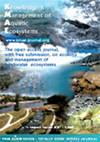Genetic diversity of endangeredChondrostoma nasusin the River Rhine system: Conservation genetics considerations on stocking and reintroduction
IF 1.7
3区 环境科学与生态学
Q3 FISHERIES
引用次数: 9
Abstract
Reintroduction, stocking and translocation of freshwater fish are of growing concern given their importance for biodiversity conservation and ecosystem functioning. For successful management and stocking programmes, it is essential to incorporate genetics-based approaches. The nase (Chondrostoma nasus) constituted one of the most common fish species in European rivers. Its highly specialised and migratory nature exposed the species to human pressures, and thus, promoted its decline. Current knowledge of the genetic structure ofC. nasusis considerably limited for Europe as a whole and for Germany specifically. To overcome this lack of information we present original data onC. nasusfrom different tributaries of the River Rhine. We analysed nine microsatellite markers and mtDNA Cytochromebsequences to assess the distribution of genetic diversity and structure of this species across the study area. With the exception of the Lake Constance/Alpine Rhine population,C. nasusexhibited high gene flow within the Rhine system, and therefore, limited geographical genetic differences between populations where migration is not prevented by human intervention. The present study provides new insights into the levels of genetic variability ofC. nasusin the Rhine system, providing useful information for guiding reintroduction and stocking programmes. Population genetic information will improve future preservation and management of this valuable freshwater fish species in Germany and beyond.濒危莱茵河系统鼻软骨瘤的遗传多样性:放养和放养的保护遗传学考虑
由于淡水鱼对生物多样性保护和生态系统功能的重要性,它们的重新引进、放养和迁移日益受到关注。要使管理和放养计划取得成功,必须采用基于遗传学的方法。鼻鱼(软骨瘤)是欧洲河流中最常见的鱼类之一。其高度特化和迁徙的特性使该物种暴露在人类的压力下,从而促进了它的衰落。目前对c基因结构的了解。对整个欧洲来说,尤其是对德国来说,这是相当有限的。为了克服这种信息的缺乏,我们提供了c的原始数据。来自莱茵河不同支流的鼻塞。我们分析了9个微卫星标记和mtDNA细胞染色质序列,以评估该物种在整个研究区域的遗传多样性和结构分布。除了康斯坦茨湖/阿尔卑斯莱茵河人口外,C。鼻塞在莱茵河系统中表现出高度的基因流动,因此,在人类干预无法阻止迁移的种群之间,地理遗传差异有限。本研究为c的遗传变异水平提供了新的见解。为指导重新引进和放养计划提供有用的信息。种群遗传信息将改善未来在德国和其他地区对这一宝贵淡水鱼物种的保护和管理。
本文章由计算机程序翻译,如有差异,请以英文原文为准。
求助全文
约1分钟内获得全文
求助全文
来源期刊

Knowledge and Management of Aquatic Ecosystems
环境科学-海洋与淡水生物学
CiteScore
3.70
自引率
5.60%
发文量
22
审稿时长
>12 weeks
期刊介绍:
Knowledge and Management of Aquatic Ecosystems (KMAE-Bulletin Français de la Pêche et de la Pisciculture since 1928) serves as a foundation for scientific advice across the broad spectrum of management and conservation issues related to freshwater ecosystems.
The journal publishes articles, short communications, reviews, comments and replies that contribute to a scientific understanding of freshwater ecosystems and the impact of human activities upon these systems. Its scope includes economic, social, and public administration studies, in so far as they are directly concerned with the management of freshwater ecosystems (e.g. European Water Framework Directive, USA Clean Water Act, Canadian Water Quality Guidelines, …) and prove of general interest to freshwater specialists. Papers on insular freshwater ecosystems and on transitional waters are welcome. KMAE is not a preferred journal for taxonomical, physiological, biological, toxicological studies, unless a clear link to ecological aspects can be established. Articles with a very descriptive content can be accepted if they are part of a broader ecological context.
 求助内容:
求助内容: 应助结果提醒方式:
应助结果提醒方式:


